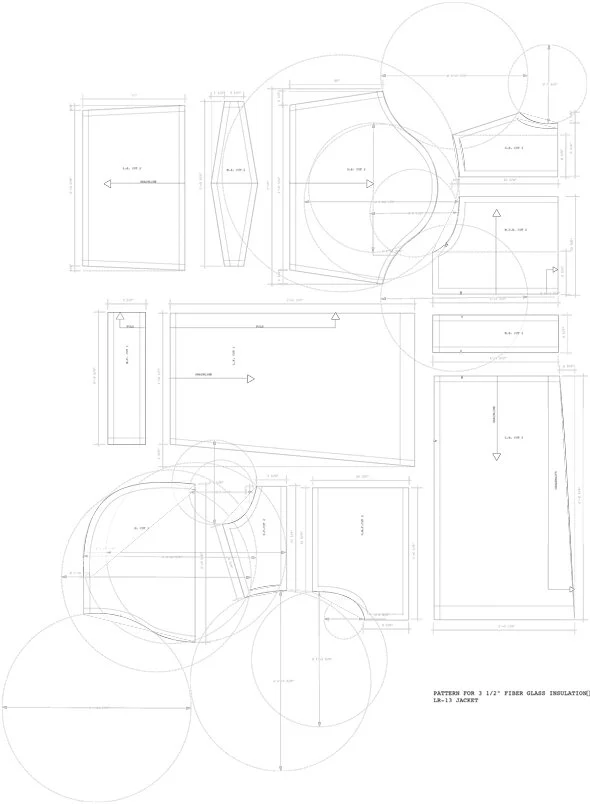R-13 Jackets
Most clothing is defined by the context in which it is worn. In today’s society we are all subject to the short lived and commercially promoted clothing that fashion magazines and retailers promote, these clothes are most often mass produced. Most people don’t think of clothing beyond it’s seasonable or decorative qualities however there is a primacy in the physical functionality of the garment in it’s provision of shelter against the elements. Clothing covers and protects the body like architecture. As John Carl Flugel observed in his book The Psychology of Clothes “ Clothes, like the house, are protective; but, being nearer the body and actually supported on it, they are (unlike the house) portable. With their help we carry – like snails and tortoises- a sort of home upon our backs, and enjoy the advantages of shelter without the disadvantages of becoming sessile.”(1) In a similar vein, Susan M. Watkins comments, “Clothing is our most intimate environment. What makes it a unique environment is that it is carried everywhere with an individual, creating its own room within a room and its own climate within the larger climate of our surroundings.”(2)
The R-13 jackets are complete and completely functional. They are made of Owens Corning batt insulation. R-13 batt insulation is a building material commonly used to insulate walls against heat loss; it is a product that has been in existence for over 50 years. Batt insulation, not unlike mass produced clothing, is a readily available, off the shelf building material that can be found in any building supply store. The availability of mass produced building materials in the south is overwhelming. Customization, in terms of clothing and housing, is almost non-existent and very rarely seen in the south. Not surprisingly, American ready to wear originated in the south in the 1830’s as clothing for slaves and laborers on the southern plantations (3).
Patterns for R-13 Jackets
Following suit, the south has become the home of the largest big box retailers in the world – Walmart and the world’s largest home improvement retailer – The Home Depot. Mass marketing and the consumption of mass produced goods pervades every phase of our life. It determines our domestic environment from the pitch of our roof to the size of our front door. The R- 13 jackets make use of relatively high performance but low-tech, ready to implement material, that is cheap and available at The Home Depot and other hardware stores throughout the United States.
The jackets take advantage of modern abundance but at the same time offer a practical solution to modern excess and abundance. The use of what today would be considered a low tech fabric to make the R-13 jackets responds to the insatiable fashion machine that drives today’s retailers of clothing and buildings. It denys the ceaseless progression of technology and innovation. In a similar way the south has always been passed by in terms of what is considered progress and innovation.
The R-13 jackets are more than fashionable garments; they are temporary shelters, clothes that are fully entitled to become architectural dwellings. They attempt to provide a safe, habitable environment for individuals who need to move around outside. They bring materials, exclusively associated with building, close to the body. By hanging a traditional building material on the body the physical structure of a building is created at an intimate scale.
1. Flugel, J. C. The Psychology of Clothes (The Hogarth Press, London, Ltd, 1930)p.83
2. Watkins, Susan M. Clothing: The Portable Environment (Iowa State University Press, Ames, 1995), p. xv
3. Paul Theobald Are Clothes Modern (Pool Brothers Inc., Chicago, 1947) p.222
Project Date: 2004
Project Team: Virginia San Fratello
VAC-PAC
The vac pac is complete and completely functional. It is made out of Tyvek, a protective material that is traditionally used as a weather-resistant barrier wrap for homes and buildings, it helps combat wind, water, moisture and air infiltration. It is a traditional building practice that has been in use for over thirty years. The use of a material such as tyvek has a history that alleviates any notions of current trends, ornament, taste or personal expression- allowing the jackets to exist outside the world of fashion but because of their inherent mode of construction they simultaneously exist outside the realm of conventional building.
vac-pac as portable shelter
vac-pac patterns
From vac-pac to inflated room
Project Date: 2004
Project Team: Virginia San Fratello, Ronald Rael





